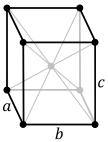Bravais lattices
There are four orthorhombic Bravais lattices: primitive orthorhombic, base-centered orthorhombic, body-centered orthorhombic, and face-centered orthorhombic.
| Bravais lattice | Primitive orthorhombic | Base-centered orthorhombic | Body-centered orthorhombic | Face-centered orthorhombic |
|---|---|---|---|---|
| Pearson symbol | oP | oS | oI | oF |
| Unit cell |  |  |  |  |
For the base-centered orthorhombic lattice, the primitive cell has the shape of a right rhombic prism; [1] it can be constructed because the two-dimensional centered rectangular base layer can also be described with primitive rhombic axes. Note that the length of the primitive cell below equals of the conventional cell above.





